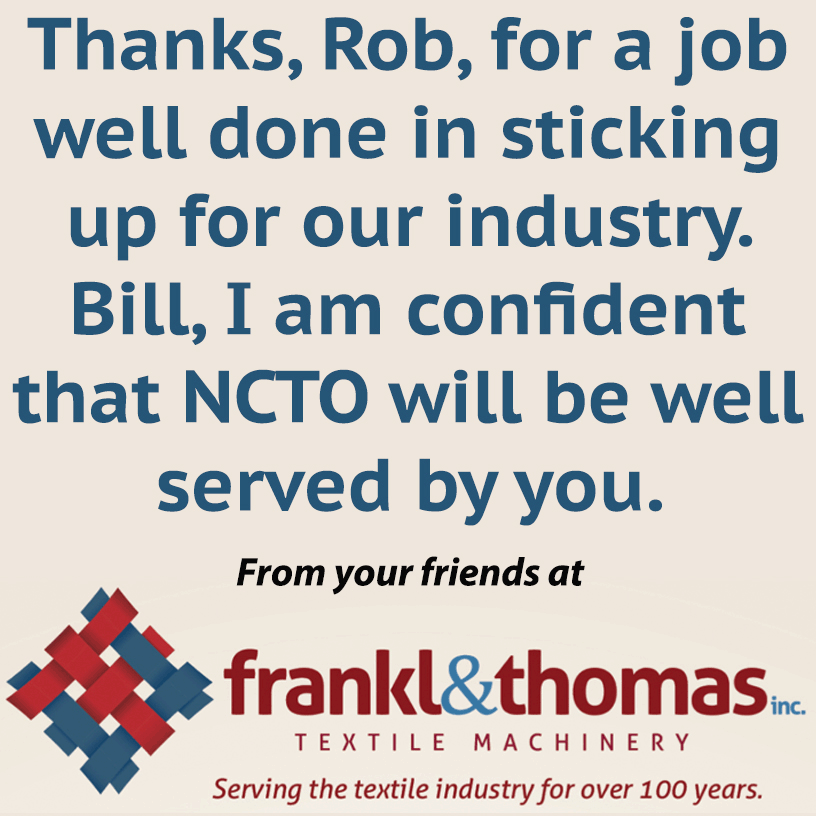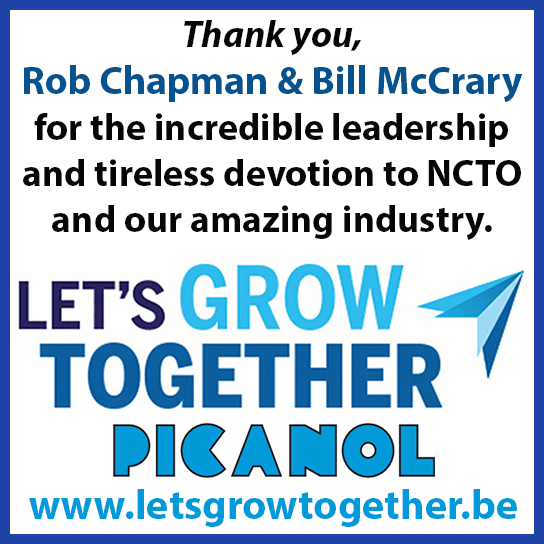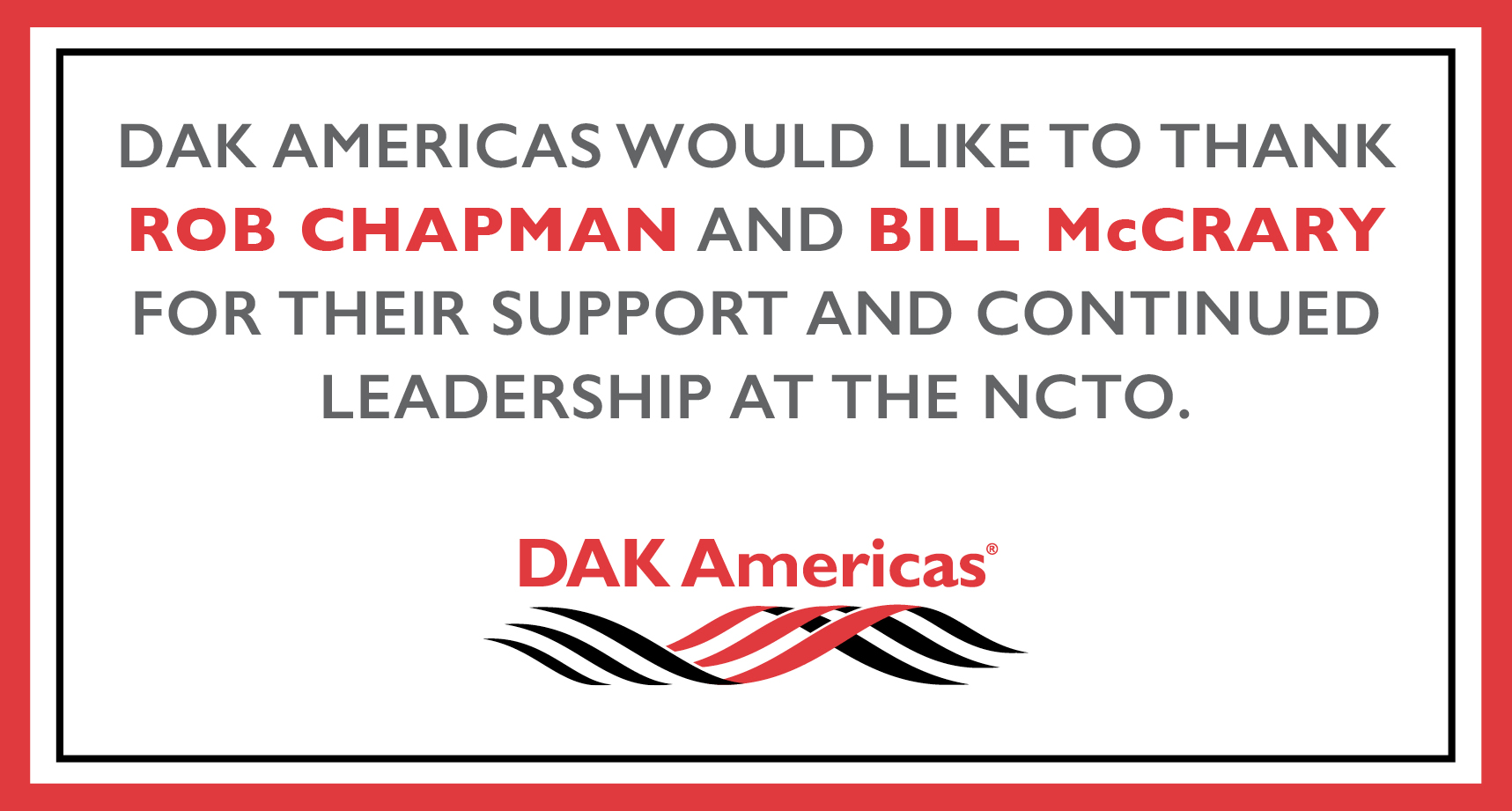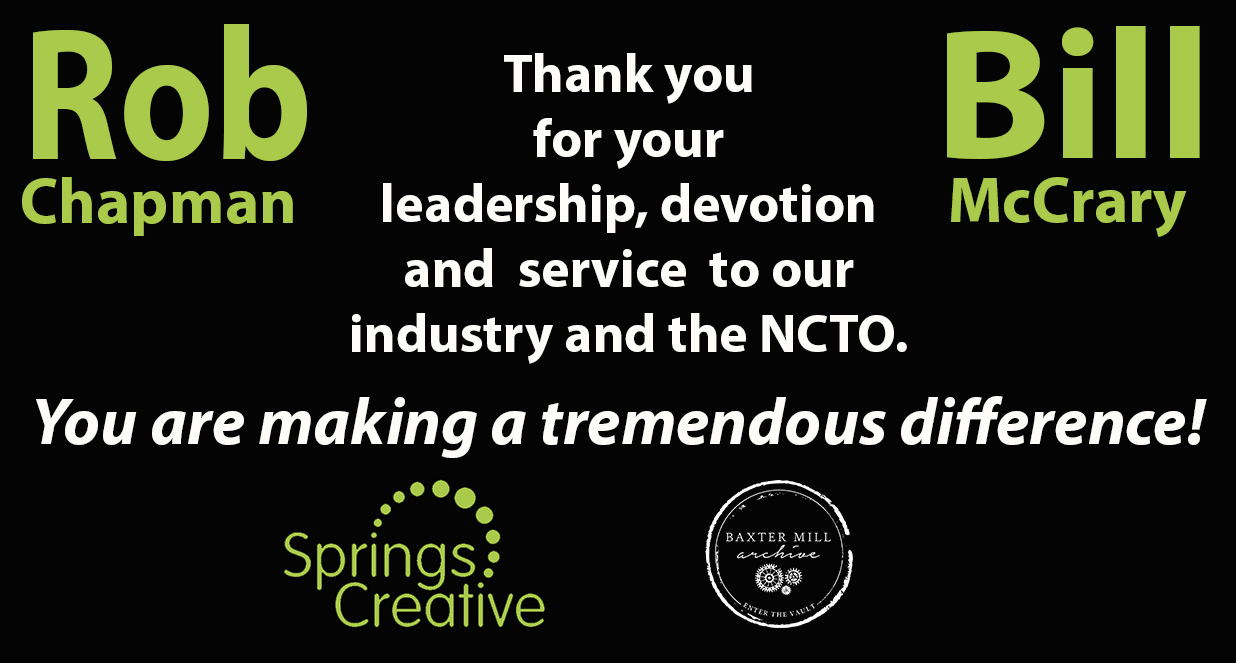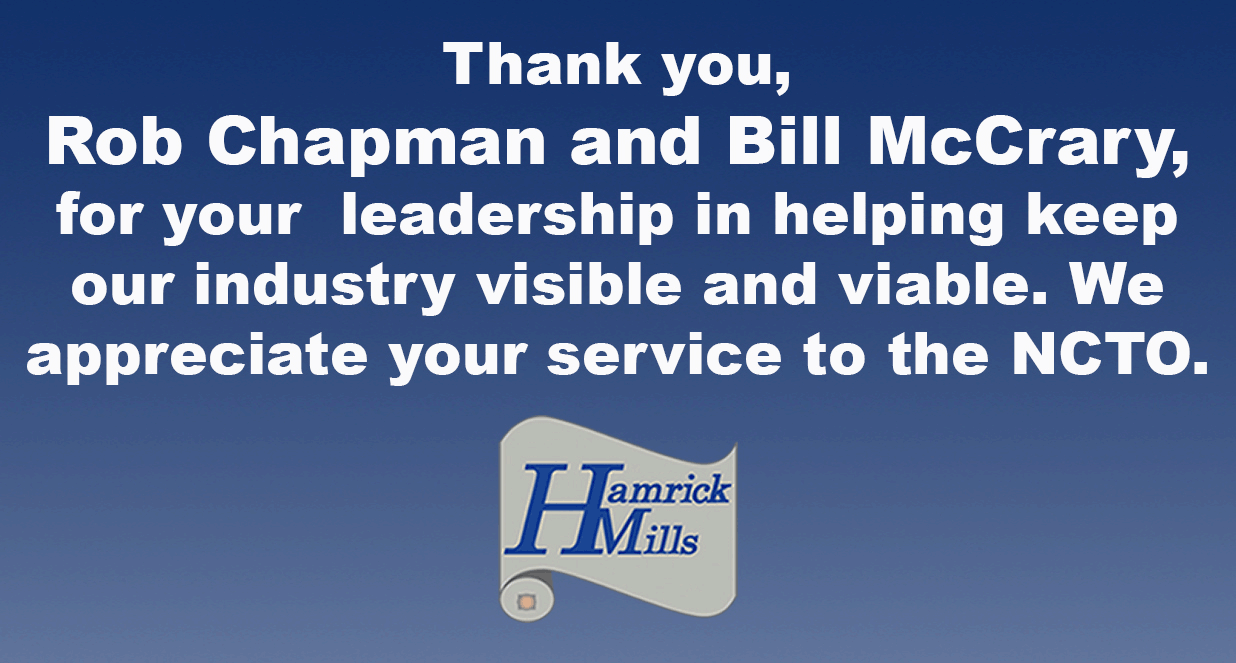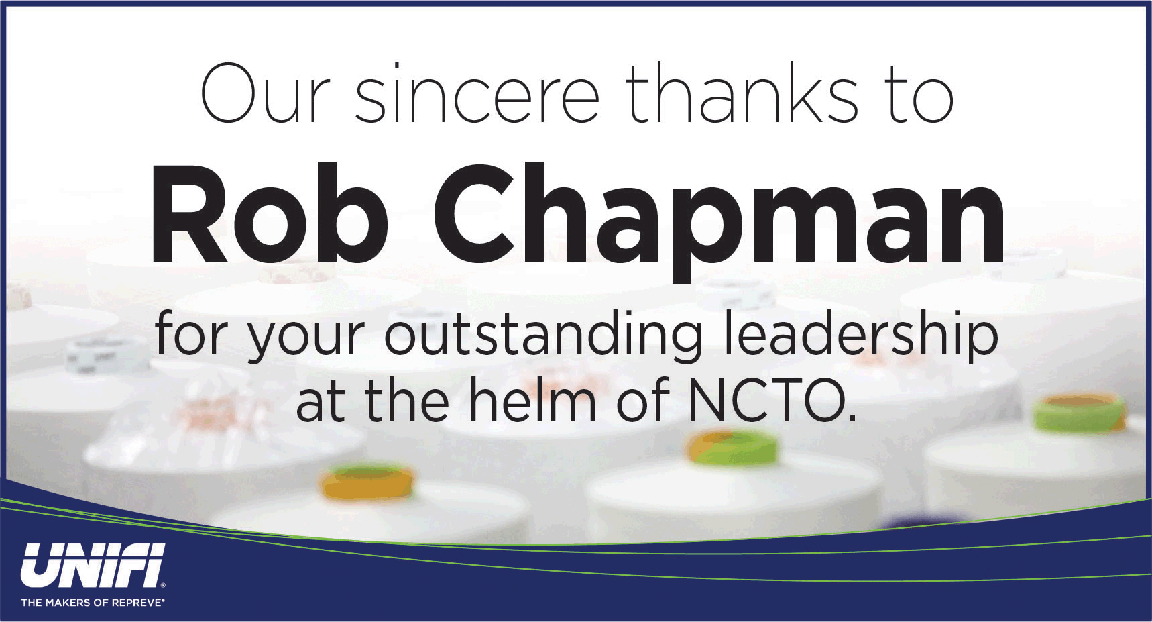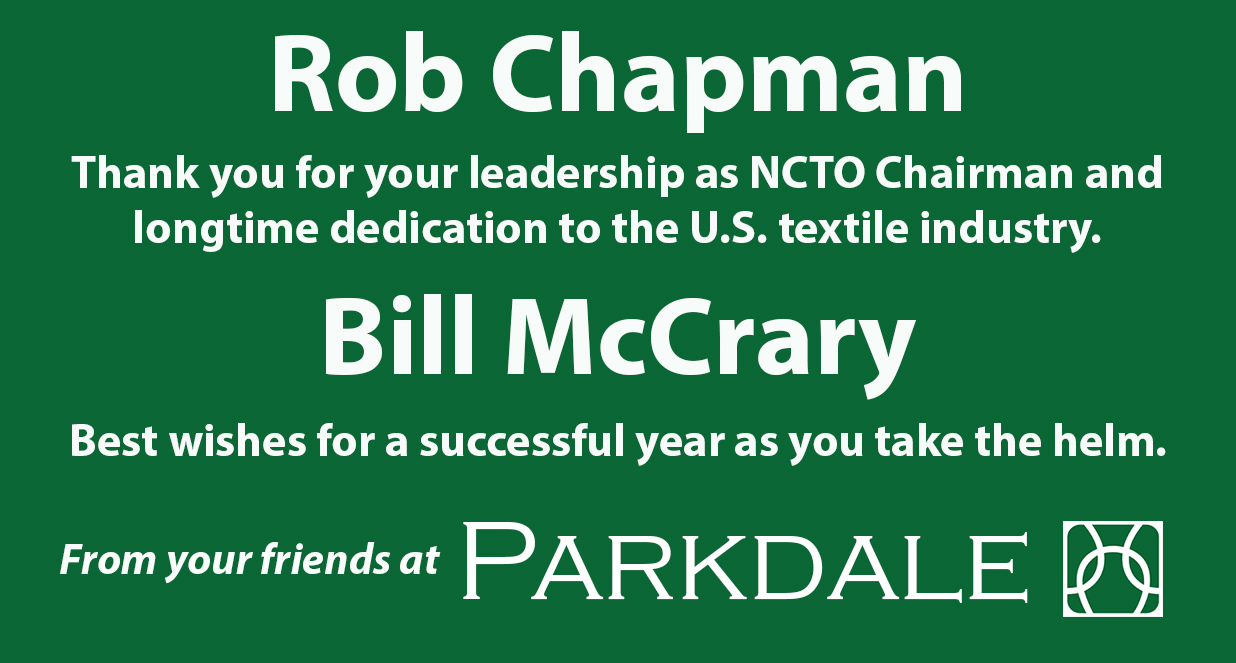
Posted March 29, 2017
By Devin Steele (DSteele@eTextileCommunications.com)
WASHINGTON, D.C. – The fundamentals of the U.S. textile industry remain sound, NCTO outgoing Chairman Rob Chapman III told a record number of attendees at the council’s 14th Annual Meeting here last week.
“This is true even though the U.S. market for textiles and apparel was soft in 2016,” Chapman, chairman, CEO and treasurer of Inman Mills, Inman, S.C., said in his 2017 State of the Industry Address. (Read the full text here.) “For the most part, the sluggishness was due to factors beyond the industry’s control: an underperforming U.S. economy, a weak global economy and disruption within the retail sector as sales shift from brick-and-mortar outlets to the internet.
“With that said,” he continued, “the U.S. textile industry’s commitment to capital re-investment and a continued emphasis on quality and innovation make it well-positioned to adapt to market changes and take advantage of opportunities as 2017 moves along.”
Following his speech, he presented the chairman’s gavel to William “Bill” V. McCrary Jr., chairman and CEO of William Barnet and Son LLC, Spartanburg, S.C., who was elected by membership during the three-day meeting. In addition, Marty Moran, CEO of Buhler Quality Yarns Corp., Jefferson, Ga., was elected vice chairman.
Nearly 150 people attended the meeting (cumulative over three days) to set the NCTO’s attendance record.
During his address, Chapman provided an overview of the economic numbers (see accompanying charts) and policy issues and an update on the NCTO’s American Textiles: We Make Amazing public relations campaign. Statistical highlights include:
-
U.S. employment in the textile supply chain was 565,000 in 2016;
-
The value of shipments for U.S. textiles and apparel was $74.4 billion last year, a nearly 11% increase since 2009;
-
U.S. exports of fiber, textiles and apparel were $26.3 billion in 2016; and
-
Capital expenditures for textile and apparel production totaled $2 billion in 2015, the last year for which data is available.
“Thanks to a laser-like focus on boosting productivity, flexibility and innovation, the U.S. textile industry has cemented its position in the global market,” Chapman said.
Related to employment figures, he added that the heavy job losses incurred because of massive import surges in the 1995-2008 time frame have “virtually stopped,” according the Bureau of Labor Statistics (BLS). Today, like most other U.S. manufacturing sectors, fluctuations in employment figures are generally due to normal business cycles, new investment or productivity increases, he said.
NAFTA countries are the most important export markets for U.S. textile exports (($11.5 billion cumulatively), followed by CAFTA-DR countries, he noted. Later, he pointed out that the NCTO strongly supports NAFTA because it is a “pillar upon which the U.S.-Western Hemisphere supply chain is built.” The council does agree with President Trump that NAFTA should be reviewed and can be improved, given that yarn-forward rule of origin language contains loopholes such as tariff preference levels (TPLs) that benefit third-party countries.
“Closing them would boost U.S. textile production and employment,” he said.
Chapman went on to say that the council strongly endorses President Trump’s call for much tougher trade enforcement. Stopping customs fraud has the twofold benefit of filling Treasury Department coffers and encouraging more production in the NAFTA and DR-CAFTA regions he noted.
Other causes for optimism
Another cause for optimism is President Trump’s forceful call to reinvigorate domestic manufacturing, Chapman said.
“For decades, U.S. policy has undervalued domestic manufacturing’s importance to America, and President Trump is right to question whether this has been good for the country,” he said. “Precisely because they will stimulate manufacturing and kick start job creation, NCTO enthusiastically endorses President Trump’s macro policy objectives of fighting for free, but fair trade, enforcing U.S. trade laws, making the U.S. tax code more internationally competitive, cutting unnecessary regulation, revitalizing infrastructure, buying American, ensuring cheap energy and fixing health care.”
The council also agrees with the president that U.S. trade policy must be changed to reflect the reality of the 21st century economy for it to truly benefit a broad swath of American society, he added. That is why the NCTO supported President Trump’s executive action to withdraw the U.S. from the 12-country Trans-Pacific Partnership (TPP) even though NCTO had endorsed the agreement last year after provisions were included in the pact to prevent any sudden surge of imports from Vietnam.
“The 2016 election of President Trump, however, brought about a dramatic change on trade,” Chapman said. “President Trump’s fundamental opposition to TPP allowed NCTO to revisit its position and communicate to his transition team soon after the election that NCTO supported withdrawal from TPP. Mindful that President Trump also had signaled interest in pursuing individual bilateral free trade agreements with TPP countries, NCTO further communicated opposition to any bilateral free trade agreement with Vietnam because of that country’s non-market economy and its demonstrated ability to disrupt the U.S. textile market.”
Additional council priorities
Another priority for the NCTO is the enactment of a Miscellaneous Tariff Bill (MTB) because the council strongly supports duty relief on manufacturing inputs that are unavailable domestically and do not compete with other U.S.-made products, he said.
“That said, NCTO is concerned that the MTB process is being abused through the filing of hundreds of petitions on finished goods, particularly apparel,” he said. “On principle, NCTO opposes MTBs on finished goods because they often compete with like products made with U.S. inputs. Duty reductions on finished textile items from any source can also undermine U.S. free trade agreements that grant duty relief through a yarn-forward rule of origin.”
Chapman also noted that the NCTO agrees that the U.S. tax code is in dire need of reform to make America more competitive internationally, and that it is pleased with the president’s initiative to cut unnecessary regulation.
He added that the NCTO also supports:
-
Rebuilding America’s infrastructure, which is a growing market for textile products such as workwear, geo-membranes, filtration systems and composites for load-bearing systems;
-
Fostering a national culture of innovation, urging President Trump to nurture the Advanced Functional Fabrics of America or AFFOA initiative;
-
The Trump administration’s commitment to “buy American,” especially as it relates to keeping the Berry Amendment strong;
-
A strong energy policy designed to keep prices low, as most manmade fibers are derivatives of petroleum products – this includes support for construction of expanded oil and gas pipeline capacity; and
-
Addressing the aging workforce issue, calling for U.S. companies to continue to forge links with local leaders, schools, government, vocational programs, community colleges, universities and state business lobbies to make sure that state and federal policy produces a labor pool both adequate in size and well prepared to succeed in a hyper-competitive global economy.
The industry’s need to attract America’s best and brightest is one reason why NCTO embarked upon therebranding campaign two years ago, Chapman said. He reported that the campaign is slowly but surely challenging outdated perceptions of the U.S. textile sector, thanks to the fact that American textile manufacturers have a great story to tell.
“Judging by the earned media and social engagement generated by American Textiles: We Make Amazing marketing efforts, more and more people are hearing the good news and viewing the U.S. textile industry in a new light,” he said.
‘Seize the generational moment’
In conclusion, Chapman said that although the U.S. textile industry has stabilized its position in the global economy, it cannot afford to rest on its laurels.
“There will always be intense and sometimes unfair competition from abroad, changing consumer demands and inevitable economic downturns,” he said. “Again, that is why it is so important for the U.S. textile industry to seize this generational moment to influence federal policies if it wants to usher in a new era of growth.”
With so much at stake in the next 12 months, members of NCTO and other textile trade associations must stay actively involved in their respective organizations, he added. In addition, all domestic textile manufacturers who have not been active in Washington, but are serious about wanting a seat at the table to change textile policy for the better, should consider joining the NCTO, he noted.
“Good policy does not materialize from thin air, and NCTO must be well financed to affect the changes that will give our sector the best chance to build a stable and prosperous future for U.S. textile companies,” Chapman said. “That’s a long way of saying the U.S. textile sector’s great workers and their families and communities are depending on the leadership of the industry’s leaders.”
During the Annual Meeting, members visited lawmakers on Capitol Hill to disseminate these messages to lawmakers.



NCTO’s 14th Annual Meeting
U.S. textile industry fundamentals remain sound, NCTO chair says
 |
|---|
 |
 |
 |
 |
 |
 |
 |
 |
 |
 |
 |
 |
 |
 |
 |
 |
 |
 |
 |
 |
 |
 |
 |
 |
 |
 |
 |
 |
 |
 |
 |
 |
 |
 |
 |
 |
 |
 |
 |
 |

In his last official duty as NCTO chairman, Rob Chapman of Inman Mills presents his State of the Industry Address during the council's Annual Meeting in Washington, D.C.
Photos by Devin Steele















